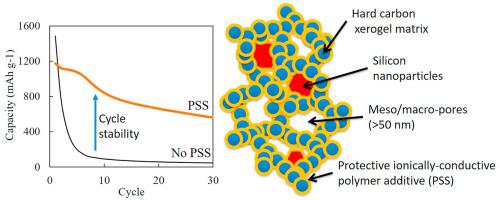Microporous and Mesoporous Materials ( IF 5.2 ) Pub Date : 2020-09-12 , DOI: 10.1016/j.micromeso.2020.110622 Joseph Carabetta , Nathalie Job

|
A composite anode comprised of silicon impregnated in a conductive carbon matrix as an anode material is an interesting path to improve the specific energy density of Li-ion batteries. However, the volume variation and SEI instability of silicon during cycling should be avoided to obtain stable electrodes. In the present study, silicon nanoparticles (SiNPs) impregnated in a 3D carbon xerogel matrix are synthesized with an ionically-conductive polymer, poly (sodium-4 styrenesulfonate) (PSS), as either a binder or a protective coating. The physico-chemical and electrochemical properties of this novel composite electrode with PSS as a coating or binder improves the retention of reversible capacity by a factor of five as compared to the same electrode using only a conventional poly (vinylidene difluoride) (PVDF) binder. Indeed, the composites with 10 wt% SiNPs utilizing PSS as a coating or binder retains a specific gravimetric energy density of 450 mAh g−1 composite after 40 cycles. Structural, textural, and electrochemical characteristics as well as prospects for further improvements of this composite anode are discussed.
中文翻译:

含聚4-苯乙烯磺酸钠作为新型保护性涂料和粘合剂的掺硅碳干凝胶
由浸渍在导电碳基质中的硅作为阳极材料组成的复合阳极是提高锂离子电池比能量密度的有趣途径。但是,应避免硅在循环过程中的体积变化和SEI不稳定性,以获得稳定的电极。在本研究中,浸渍在3D碳干凝胶基质中的硅纳米颗粒(SiNPs)与离子导电聚合物聚(4-苯乙烯磺酸钠)(PSS)作为粘合剂或保护性涂层合成。与仅使用常规聚偏二氟乙烯(PVDF)粘合剂的同一电极相比,这种以PSS作为涂层或粘合剂的新型复合电极的物理化学和电化学性质将可逆容量的保留提高了五倍。确实,40次循环后-1复合。讨论了该复合阳极的结构,结构和电化学特性以及进一步改进的前景。


























 京公网安备 11010802027423号
京公网安备 11010802027423号